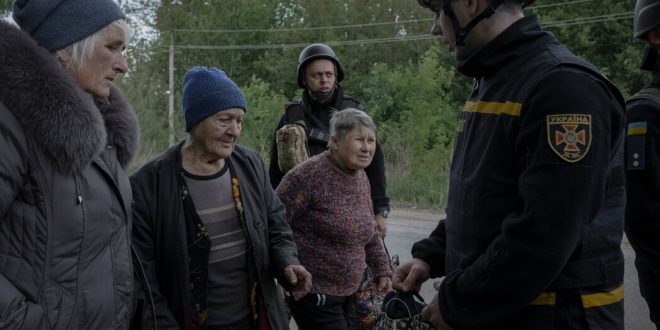In the past three days, Russian troops, backed by fighter jets, artillery and lethal drones, have poured across Ukraine’s northeastern border and seized at least nine villages and settlements, and more square miles per day than at almost any other point in the war, save the very beginning.
In some places, Ukrainian troops are retreating, and Ukrainian commanders are blaming each other for the defeats.
Thousands of Ukrainian civilians are fleeing to Kharkiv, the nearest big city. A reception center that hummed with a sense of order and calm on Saturday had transformed into a totally different scene on Sunday, as exhausted people shouted at each other and families with no place to go spilled out onto the grass.
As anxiety spreads, some hard questions loom: How far will this go? Is it just a momentary setback for the underdog Ukrainians? Or a turning point?
Military experts say the Russian advance has put Ukraine in a very dangerous spot. Ukrainian troops have been complaining for months about severe shortages of ammunition — exacerbated by the tangles in the U.S. Congress that delayed the delivery of key weapons. And Ukrainian soldiers, by all accounts, are exhausted.
More than two years of trying to fight off a country with three times the population to draw from has left Ukraine so depleted and desperate for fresh troops that its lawmakers have voted to mobilize convicts, a controversial practice that Ukraine had ridiculed Russia for using in the first half of the war.
One Ukrainian commander took the unusual step on Sunday of blasting his colleagues for what he said were terrible border defenses.
“The first line of fortifications and mines just didn’t exist,” Denys Yaroslavsky, a reconnaissance commander, wrote on Facebook. “The enemy freely entered the gray area, across the border line, which in principle should not have been gray!”
(“Gray” areas are the contested zones between the Russian and Ukrainian front lines.)
Other Ukrainian officials denied that the country’s forces were unprepared, saying that reports suggesting so were outright disinformation benefiting Russia.
Commander Yaroslavsky added that street fights had broken out in Vovchansk, a small town near Kharkiv, and that it was now surrounded. “I say this because we can die and no one will hear the truth,” he wrote. “Then why is it all for?!”
The city of Kharkiv itself is safe — at the moment. It sits about 20 miles from the border. But just outside the city, people are running for their lives. The Russians are pressing on Lyptsi, another small town that is even closer to Kharkiv than Vovchansk. Residents who fled in evacuation vans on Sunday said the situation in Lyptsi was not looking good.
“For the last three days they were shelling us every 10 minutes,” said Halyna Surina, who escaped on Sunday afternoon. “There was artillery, airplane bombs and drones flying around. I could hear helicopters — and they were not our helicopters.”
Her voice was shaking and she could barely choke out the words.
Taking Lyptsi would put the Russians within artillery range of Kharkiv, a metropolis of more than a million people that was just struggling to come back to life. All this, for the Ukrainians, is a bad case of déjà vu.
The Russians created a similar situation in early 2022, storming across the northern border, occupying villages and small towns, and reaching the ring road that circumscribes Kharkiv. For months, the people of this city endured artillery and missile strikes, and hundreds were killed. The tall, empty apartment buildings on the eastern side of town stand as scorched monuments to those deadly days.
Part of the Russians’ plan with this overall attack, military analysts said, is to threaten Kharkiv and force Ukraine to divert troops from other battlefields, especially those in the eastern Donbas region.
And that’s exactly what is happening. A group of Ukrainian special forces soldiers were huddling at a gas station on Sunday afternoon, swigging energy drinks and trying to get the lay of the land. They looked tired. And they said they had just been redeployed from Donbas.
“The Russians have understood, just as a lot of analysts have, that the major disadvantage that Ukraine is currently suffering from is manpower,” said Franz-Stefan Gady, a Vienna-based military analyst. “By thinning out the front line, you are increasing the odds of a breakthrough.”
There may be an even bigger, more strategic motive. President Vladimir V. Putin of Russia is fresh off an election victory that he billed as a referendum on launching this war. For his troops to threaten Kharkiv, again, and send miles of cars full of terrified civilians fleeing down the highways, again, and turn Ukraine’s second largest city into a shell of itself, again, could demoralize Ukrainians and its allies.
That hasn’t happened yet, but if it does it could give the impression that after two years and hundreds of thousands of casualties and billions of dollars, little has changed. That, in turn, would perhaps intensify pressure on Ukraine’s leaders to negotiate a truce with Russia, which they have so far insisted would achieve nothing but cementing Mr. Putin’s appetite for aggression.
With fighting raging in the area, cross-border fire has intensified and Russia on Sunday accused Ukraine of shelling Belgorod, a mid-sized Russian city just across the Ukrainian border, killing 11 people, the regional governor said on Telegram.
In particular, an explosion collapsed part of an apartment building, leaving a gaping hole in its structure. The Russians blamed the Ukrainians; the Ukrainians denied it and provided videos that they said showed what was an explosion within the building and not an airstrike.
The Russians have cited previous strikes on their cities to justify taking more Ukrainian territory. Russian leaders want to push Ukrainians back from the border and carve out a buffer zone, a mission they began on Friday at dawn.
Russian infantry, supported by tanks, artillery and aircraft, crossed the international frontier, and by Saturday, they had taken a handful of towns. By Sunday, more had fallen.
Another Ukrainian soldier serving near Kharkiv who spoke by telephone on Sunday said he and his comrades hadn’t slept in days and were in shock at how fast the Russians were moving.
Gen. Oleksandr Syrsky, Ukraine’s top military commander, conceded that the situation had “significantly worsened” but said that Russian attempts to break through Ukrainian defensive lines had been unsuccessful so far.
Some analysts believe that however bad the situation looks at the moment for Ukraine, it won’t change the overall direction of the war.
Thibault Fouillet, the deputy director of the Institute for Strategic and Defense Studies, a French research center, said it would have “little impact on the war in general” and for now, the fighting remained at a “general tactical stalemate” with Russia making limited and costly gains.
The civilians in Russia’s path are not taking chances. Ukrainian officials reported on Sunday that 4,500 people had been evacuated from the border towns north of Kharkiv; that doesn’t count many more who have jumped into their own cars and gotten out.
“We could hear machine gun fire coming closer and closer,” said Zhenia Vaskivskaia, who had just arrived in Kharkiv from Vovchansk.
The Russians, she said, were “about to break in.”
Oleksandra Mykolyshyn contributed reporting from Kharkiv.
 Top Naija News – Nigeria News, Nigerian News & Top Stories Top Naija News – Nigerian Newspapers, Nigerian News. topnaijanews is a daily Nigerian newspaper covering Latest News, Breaking News, Entertainment, Sports, Lifestyle and Politics.
Top Naija News – Nigeria News, Nigerian News & Top Stories Top Naija News – Nigerian Newspapers, Nigerian News. topnaijanews is a daily Nigerian newspaper covering Latest News, Breaking News, Entertainment, Sports, Lifestyle and Politics.




